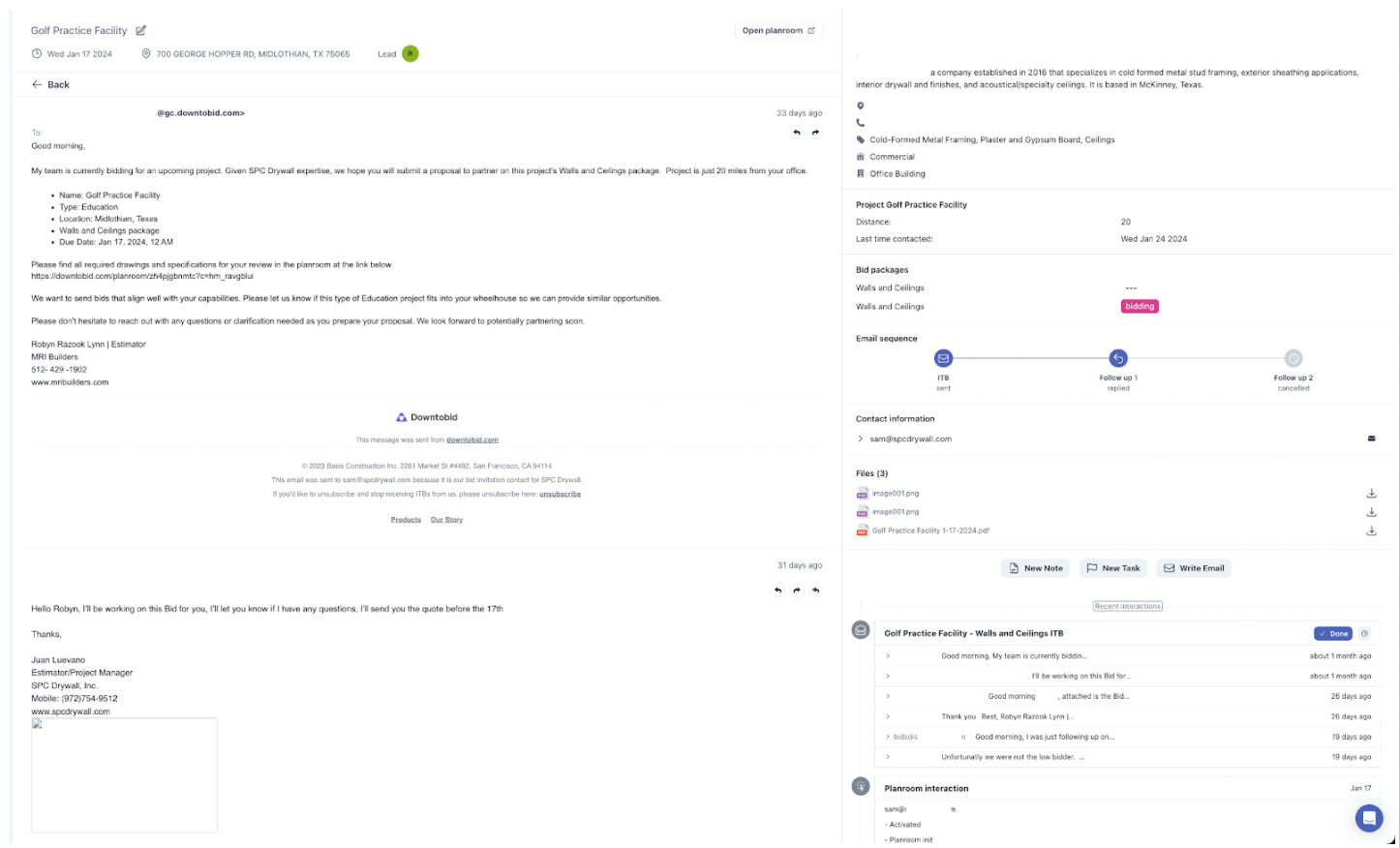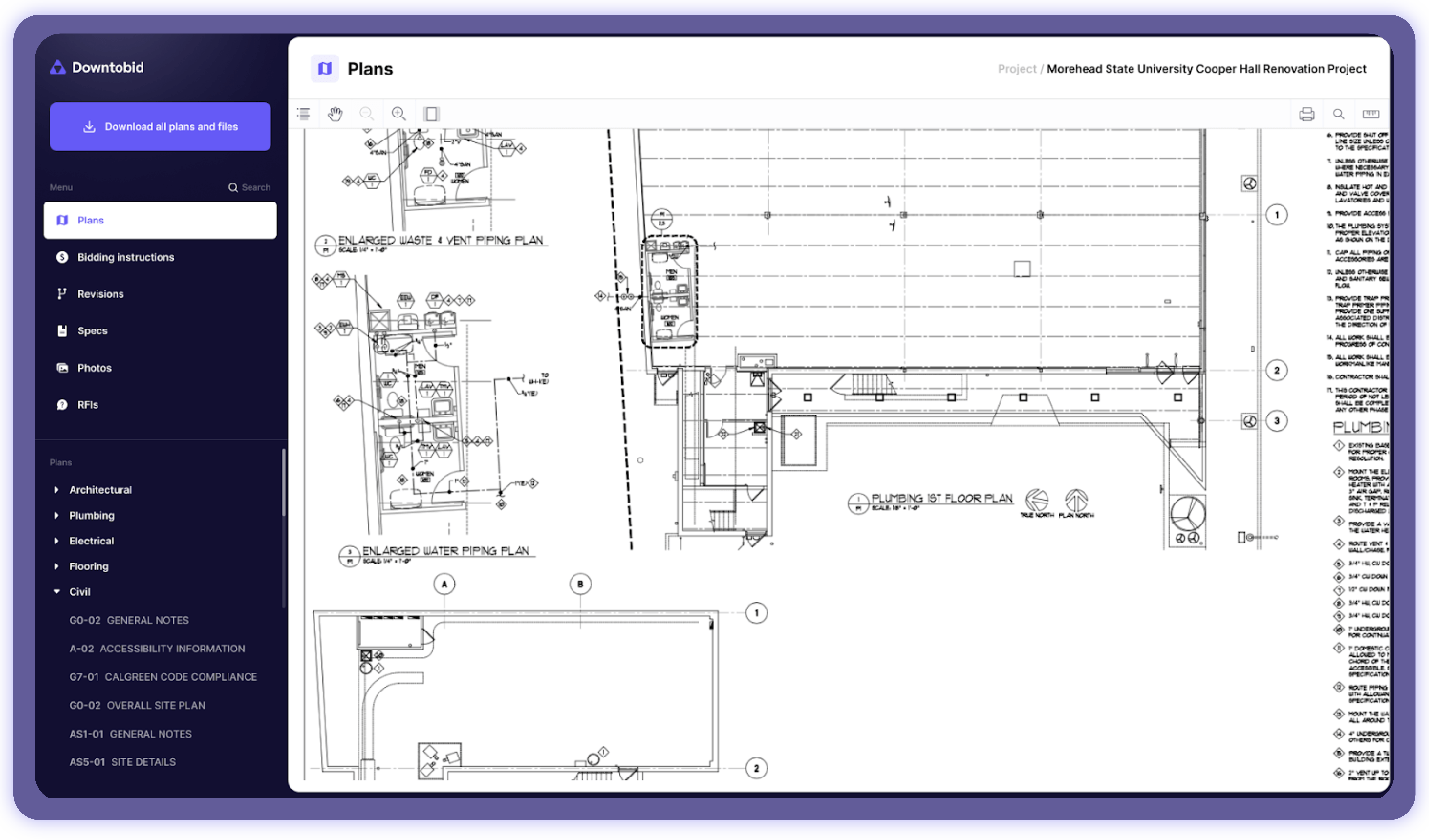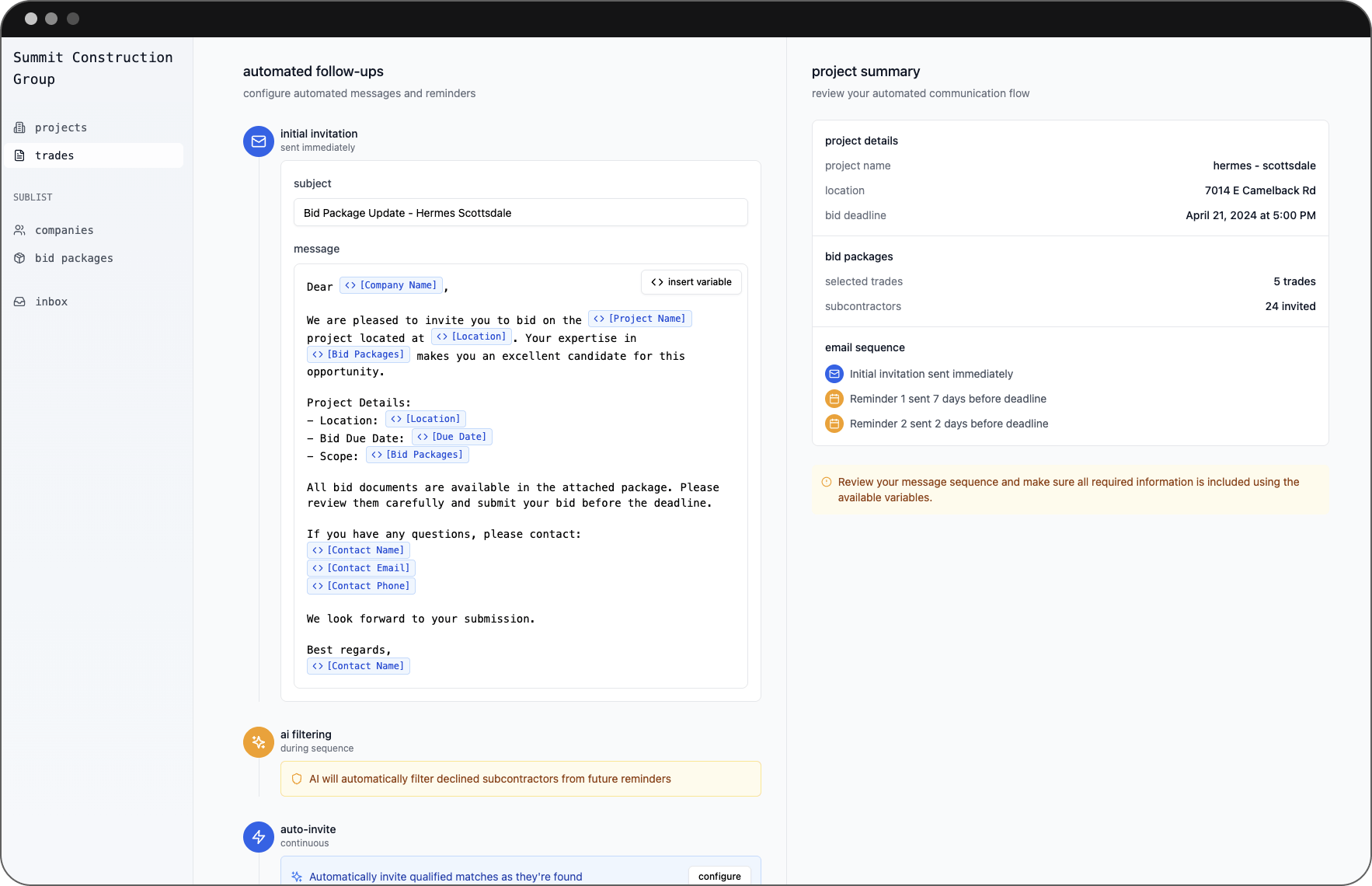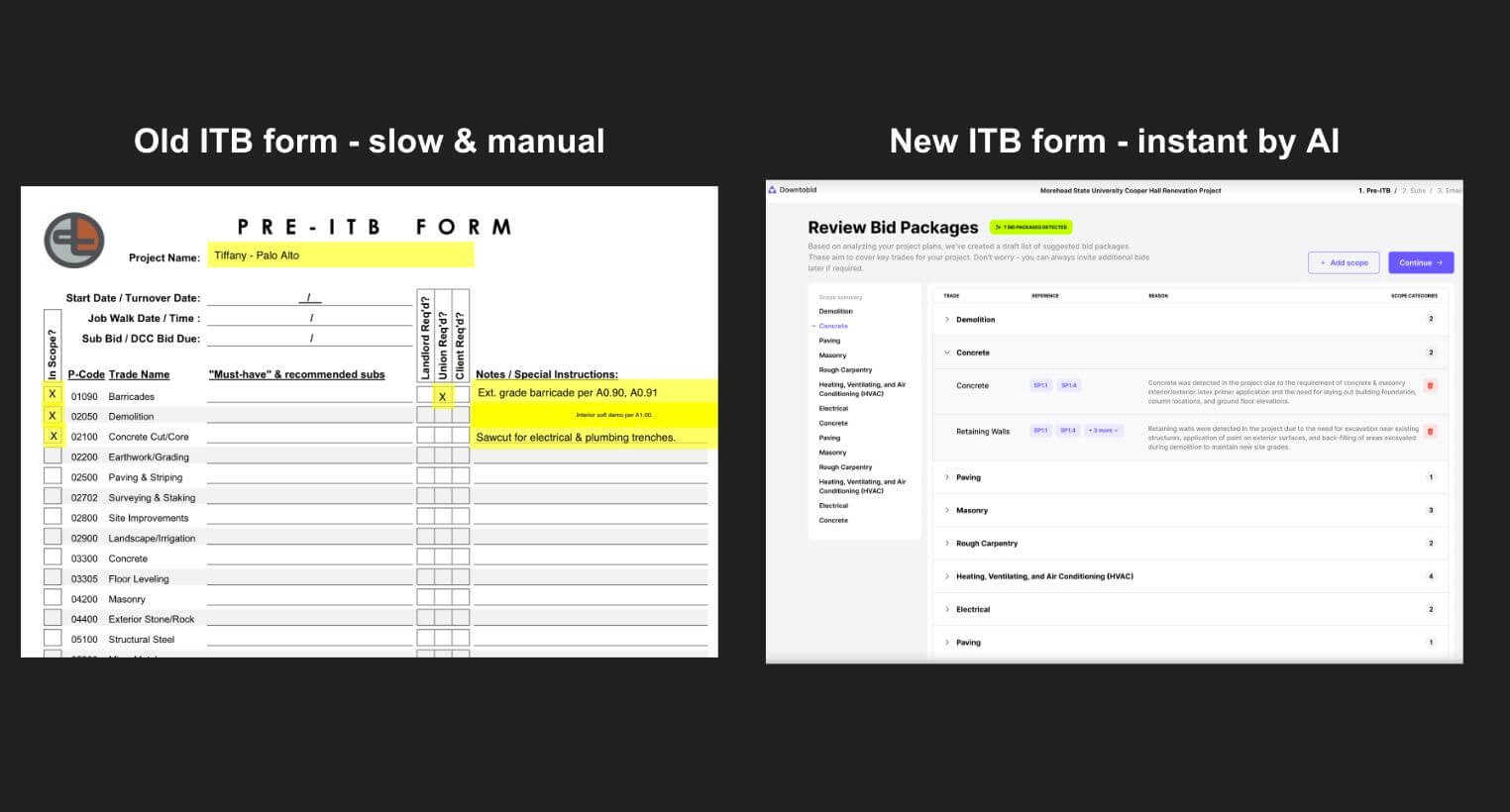Time’s always tight when you’re running a construction project, and as a general contractor, you need a bid management platform that connects you with the right subcontractors and makes the whole process as seamless as possible.
PlanHub might be a name you’ve come across, but if you’ve done a quick Google search, you’ve likely seen mixed reviews – some users praise it, while others have strong reservations.
When you’re weighing your options for bid management platforms, it’s worth considering these 3 key questions:
- How comprehensive is the bid coverage?
- Does the platform promote clear, efficient GC-subcontractor communication?
- Do the features and benefits justify the cost, or does a better-value option exist?
This guide will tackle these questions to help you figure out if PlanHub is the right tool for your needs. We'll go over the pros and cons, abd PlanHub reviews. Plus, we’ll introduce you to a better alternative that might just check all the boxes.
Note: If you want to send personalized invites in minutes to the right subs, try Downtobid. Our software uses AI to break down project plans, ensures 100% scope coverage, and automatically sends personalized bid invites with relevant project details. Try a demo of Downtobid for free today.
Key Takeaways
- PlanHub offers free registration, unlimited projects but forces sub accounts, paid viewing for GC contact info, reducing engagement.
- Uses low-engagement "Yes/No/Maybe" buttons without bounce tracking, leaving GCs guessing about coverage and intent.
- Downtobid uses personalized email ITBs with 30% higher responses, AI response categorization, no-login planrooms.
- PlanHub pricing: $1,199-$3,299 annually based on radius coverage, opaque Enterprise pricing.
- Downtobid transparent pricing: free for 2 projects, with scope detection, qualified matching.
How We Tested PlanHub
To provide you with an accurate, unbiased assessment of PlanHub, our team conducted a comprehensive 30-day evaluation using real construction projects from our network of general contractor partners.
PlanHub Summary
PlanHub has its merits for GCs. It’s free to register, you can post unlimited projects to find subcontractors, and share relevant files and information with them. Plus, you get features like activity tracking to see who’s bidding (or not), bid organization, instant messaging, and unlimited file storage.
However, the subcontractor experience on PlanHub isn’t as smooth. Subcontractors face several hurdles that can make the platform less appealing:
- You are required to create an account to access the platform.
- Viewing certain projects or even seeing which GCs sent a bid invite often requires a paid subscription.
- Without paying, you can’t view the contact information of the GCs, making it difficult to ask questions or get clarity on bids.
When you compare PlanHub with Downtobid, these obstacles can discourage subs from fully engaging with the platform, and that can affect you as a GC. If subs aren't motivated to use the platform, it can ripple back to you, making it harder to manage and execute your projects efficiently.
For example, you might see:
- Fewer responses to bid invites, potentially slowing the construction bidding process and leading to higher project costs or delays.
- Miscommunication or incomplete bids due to subcontractors' inability to ask questions or clarify details easily.
With all that in mind, let’s take a closer look at some concrete reasons why PlanHub might — or might not— be the right platform for you.
PlanHub Reviews: What Users Are Actually Saying
When you're evaluating any bid management platform, it's smart to look beyond the marketing materials and see what actual users are experiencing day-to-day. The reality from verified G2 reviews paints a concerning picture of PlanHub's user satisfaction.
The Numbers Don't Lie
Based on verified user feedback, the most common complaints center around issues that directly impact your bottom line:
- High costs - Users consistently cite PlanHub as expensive, especially when weighing the features you actually get
- Poor file organization - Finding and managing project documents becomes a daily frustration
- Difficult navigation - The platform creates unnecessary friction in workflows that should be streamlined
- Technical problems - Bug issues and system inconsistencies interrupt critical bidding processes
Real User Experience
One verified construction professional in the mid-market space gave PlanHub a brutal 1-star rating, calling the software "lacking." Despite appreciating the ability to see competing GCs on projects, they reported that PlanHub fails to provide essential project details like start dates, budgets, tax-exempt status, and prevailing wage requirements. Most telling? When asked what problems PlanHub solves, their response was blunt: "None."
This feedback aligns with what we see across the industry — while PlanHub offers basic bid distribution, it's missing the project intelligence and user-friendly experience that construction professionals actually need to run efficient bidding processes.
When your subcontractors are frustrated with the platform, that frustration flows directly back to you through fewer bid responses and delayed project timelines.
PlanHub Pros & Cons
Here's what users like about PlanHub:
- Straightforward interface - Multiple users highlight the platform's intuitive design that doesn't require extensive training
- Wide subcontractor network - Access to a broad range of subs and suppliers for project connections
- Simple document access - Drawing and estimation tasks are streamlined once you're in the system
- Responsive support team - Customer service receives praise for being helpful when issues arise
- Faster project workflows - Users report improved efficiency in managing bid processes compared to manual methods
Here's where PlanHub falls short:
- High annual costs - Users consistently mention pricing as a major concern, especially for smaller operations
- Messy file management - Uploaded folder structures don't stay organized, creating document chaos
- Hard-to-find information - Poor file naming and organization make retrieving project details time-consuming
- Technical glitches - Bid submission failures and system bugs create workflow interruptions
- Inconsistent experience - Platform design and organization vary across different sections, confusing users
How Comprehensive is the Bid Coverage?
The more bids you receive, the more options you have to work with. It gives you a clearer picture of market conditions and lets you choose the most qualified subs based on cost, qualifications, and availability. High bid coverage means you’re engaging a wide range of subcontractors, while low coverage might suggest they’re not all that interested — or worse, they’re not participating at all.
That’s why bid coverage is the first area where we're putting PlanHub to the test; if it’s truly a valuable tool, it needs to excel here.
To properly assess how PlanHub fares in this category, you need to first understand the key factors that drive subcontractor participation. Two main conditions must be met to maximize engagement:
- Subcontractors should receive invitations only for projects that align closely with their expertise.
- The platform should provide easy access to project plans and documents; the easier it is for them to see what’s involved, the more likely they are to bid.'
Matching Invitations to Subcontractor Expertise
PlanHub tries to tackle the first point with something pretty standard in construction bidding: Bidding Intent buttons. While it’s a staple feature, it has its flaws.
In fact, research shows that these buttons often get low engagement because they force subs to respond with a simplistic "Yes/No/Maybe." There's no room for nuance, clarifications, or showcasing their capabilities.
For this reason, you’ll often find a lot of subs in your bid packages marked as "Undecided." And this situation leaves you in a tough spot because you have to follow up with phone calls — a big time sink that typically leads to even more frustration when you encounter invalid or incorrect contact information.
To make things worse, PlanHub doesn’t display bounce rates, so you’re left guessing whether your bid invites even reached the right people. This makes it harder to gauge real bidding intent, which can skew your coverage data and make it tough to see how competitive your bids actually are.
Downtobid takes a different approach to solving this problem. Our philosophy is simple: make everything as easy as possible for the subcontractor.
Instead of relying on low-engagement buttons, we use personalized, email-based Invitations to Bid (ITBs), which significantly boost response rates. In fact, we see a 30% higher reply rate on these ITBs.

But we don’t stop there; we use AI to automatically categorize subcontractor responses — whether they're not bidding, interested, or actively bidding. This gives you a highly accurate representation of your bid coverage without the need for endless follow-up calls.
And because our system uses regular email communication, subcontractors can respond directly to your ITBs. This allows you to focus on building relationships rather than managing bid status fields.
Making Project Plans and Documents Easy to Access
For any bid management platform, making project documents easy to access is key. PlanHub tries to do this with its Plan Room, which serves as a centralized spot for all project-related documents. Here’s what it offers:
- You can upload and share all necessary drawings and specifications for each project.
- All bids submitted by subcontractors are organized in one place so you can review and compare them.
- It tracks communications regarding project updates, bid submissions, and requests for information (RFIs).
But here’s the catch: not every GC organizes their Plan Room the same way. Sometimes, you’ll end up with a big, flat file structure where subs have to download everything just to find their specific scope. This extra hassle can discourage subs from engaging fully with your project, which is the last thing you want when time is running low.
In contrast, Downtobid makes document access straightforward with a self-serve, no-login-required Plan Room. Unlike PlanHub, we don’t force subcontractors to create an account, ensuring everything is as sub-friendly as possible.

We also auto-organize the Plan Room for the GC into four specific folders:
- Plans
- Specs
- Photos
- Misc
This setup makes it easy for subs to find what they need since it aligns with what they’re used to. Plus, in the Plan Room, we automatically sheet, index, and title every single page. This way, the sub can quickly go directly to their relevant pages to see if the plans are a good fit for them.
Does the Platform Facilitate Clear GC-Subcontractor Communication?
In an industry as complex and detail-oriented as construction, human connection is still crucial. And that connection often begins — or falters — with the first message you send to potential subs: the Invitation to Bid. This initial outreach can set the tone for the entire relationship, making it a key element of your preconstruction process.
Unfortunately, this is where PlanHub falls short. The platform doesn’t allow you to customize ITBs with details about the project or even introduce yourself. Subcontractors are forced to click into the platform just to figure out if the project is relevant to them. This lack of upfront detail creates friction, causing a significant drop-off as subs either don’t know who you are or have to go through the hassle of logging in and creating an account on PlanHub to view the plans.
For a platform where many users and subs report getting flooded with emails about projects that don’t match their trade or location, the last thing you want is for your ITB to end up in a spam folder or get overlooked because it’s too generic.
Sending Personalized ITBS with Downtobid
To maximize engagement, the bid solicitation process must prioritize subcontractor needs and create a seamless experience from initial outreach through bid submission. Using generic bid invitation email templates may not get the most responses.
For this reason, your ITBs should:
Make it clear that the potential subs are the perfect fit for the job by recognizing their skills and experience.

Offer enough information upfront with a clear scope of work so subs don’t have to dig through complex plans to figure out if they can handle the job.
Use attention-grabbing subject lines that include details like project size, type, and location to spark interest and drive your open rates.
Send 2-3 follow-ups, spaced out appropriately based on the bid timeline, to show respect for their time while demonstrating your commitment to the project.
Thankfully, our platform does all of this seamlessly.
After uploading your construction plans, our AI identifies relevant bid packages and curates a tailored list of local, prequalified subcontractors based on their capabilities. It then drafts personalized bid invitations with attention-grabbing subject lines and concise scope summaries.

You can introduce yourself, provide detailed project information, and highlight why this opportunity is a good fit for the subcontractor.
In short, Downtobid makes it easier for subs to say "yes" to your projects by removing barriers and enhancing the entire communication process. The result? Higher engagement, more bids, and ultimately, better project outcomes.
Does PlanHub Justify Its Cost?
When evaluating any construction software, the key question isn't just "how much does it cost?" but rather "does the value delivered justify the investment?"
PlanHub's pricing structure has been criticized for its lack of transparency and high annual fees. The platform requires subcontractors to pay annual fees ranging from over $1,000 to $3,000+ depending on their coverage area, which can significantly impact your bid participation rates as a general contractor.
As for the Enterprise plan, you'll need to contact sales to get a quote, which adds to the perception of a lack of pricing transparency. If this is a big problem for you, you may take a look at alternatives to PlanHub.
More concerning from a value perspective are the participation barriers that affect your project outcomes:
- Reduced bid responses when subcontractors can't easily access project details without paid accounts
- Communication friction that leads to incomplete bids and project delays
- Limited project intelligence with basic features that don't match the price point
The real question becomes: are you getting measurable ROI through improved bid coverage, faster project timelines, and better subcontractor relationships?
The concern grows even further when considering the limitations imposed on non-subscribers. For instance, you need a paid account to access job details and drawings from certain general contractors, creating a barrier for those looking to bid on projects. If this is a big problem for you, you may take a look at comparing PlanHub to ConstructConnect and Downtobid.
In contrast, Downtobid takes a different approach. You can start using our software at no cost with our free plan, which includes unlimited users and allows your entire team to manage two active projects simultaneously.
For those who need to handle more projects, we offer the Basic Plan for 3 users or Pro plan which allows for up to 10 users. You only pay for what you need, with no hidden costs or barriers to entry. You can learn more about PlanHub's pricing here.
Is Planhub Worth it? Final Thoughts
General contractors typically focus on two critical objectives during the construction bidding phase:
- Complete scope coverage
- Securing an ideal number of subcontractor bids
Unfortunately, PlanHub falls short in these areas. Unlike Downtobid, PlanHub doesn’t offer a comprehensive way to scope out your projects or provide a curated list of qualified subs to contact. The process for inviting and communicating with subs remains clunky and could definitely use some improvement.
On top of that, PlanHub’s pricing can be quite steep. Given the cost, it’s worth considering trying out a platform like Downtobid for free.
With Downtobid, you can:
- Enhance page turn: AI checks all major trades to prevent missed scope and provides brief summaries.
- Identify scopes within complex construction plans: Get suggestions for the right bid packages and match them with a list of qualified, local subcontractors.
- Send personalized invitations: Include comprehensive scopes of work and sheets with each invitation to bid, reducing scope gaps during the preconstruction phase.
Give Downtobid a try (for free) and see how it can streamline your bidding process and help you achieve better results.
Frequently Asked Questions
Is PlanHub worth the cost for general contractors?
PlanHub's high annual costs, starting from $1,199 to $3,299 depending on radius coverage, and opaque Enterprise pricing make its value questionable for general contractors. The platform imposes participation barriers for subcontractors by charging fees to view key project details and GC contact info, leading to reduced bid responses.
Given these challenges and the lack of advanced project intelligence features at the price point, many users feel that PlanHub does not deliver sufficient ROI on its cost. Alternatives like Downtobid, which offers transparent pricing, free plans for small project loads, and enhanced features, may offer better value .
What are the most common complaints about PlanHub?
The leading complaints include high pricing, poor file and document management, difficult and inconsistent navigation, and technical glitches such as bid submission failures.
Users also report that the platform creates friction in workflow with its low-engagement bidding intent options and lack of bounce tracking. These issues result in inefficiencies and frustration that negatively impact project timelines and bid competitiveness .
How does PlanHub compare to other bid management platforms?
Compared to alternatives like Downtobid, PlanHub falls short in bid coverage and seamless communication. Downtobid uses AI to ensure 100% scope coverage, sends personalized ITBs that yield 30% higher response rates, and has a self-serve, no-login-required Plan Room organized for ease of use. In contrast, PlanHub relies on simple Yes/No/Maybe buttons with no bounce tracking and has a flat file structure that complicates document access.
Additionally, Downtobid’s pricing is transparent and more flexible, whereas PlanHub’s pricing is higher and less clear. Many users prefer platforms like Downtobid for better subcontractor engagement and overall bidding efficiency .